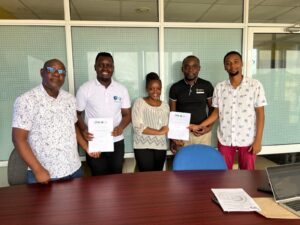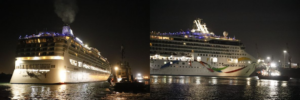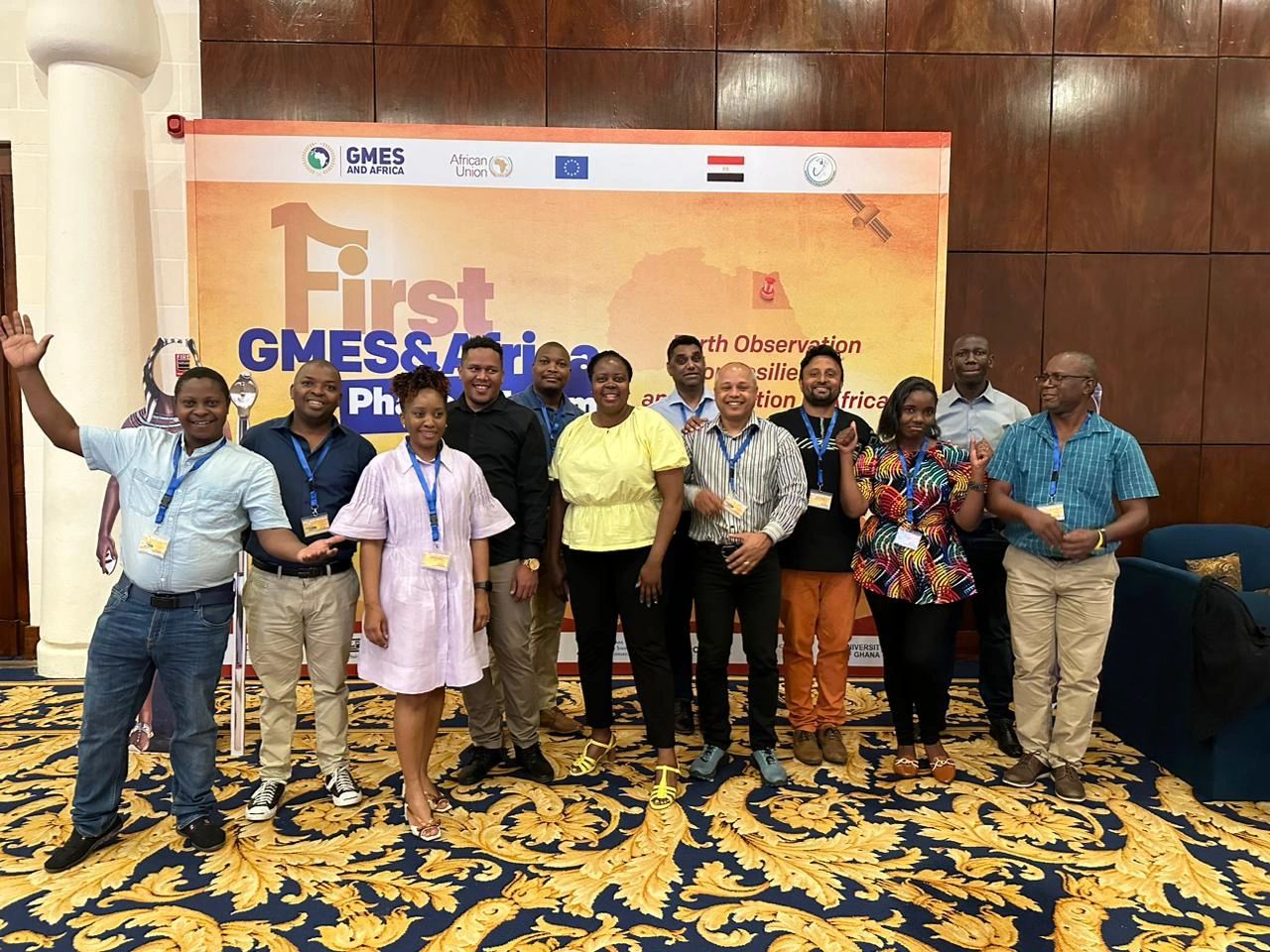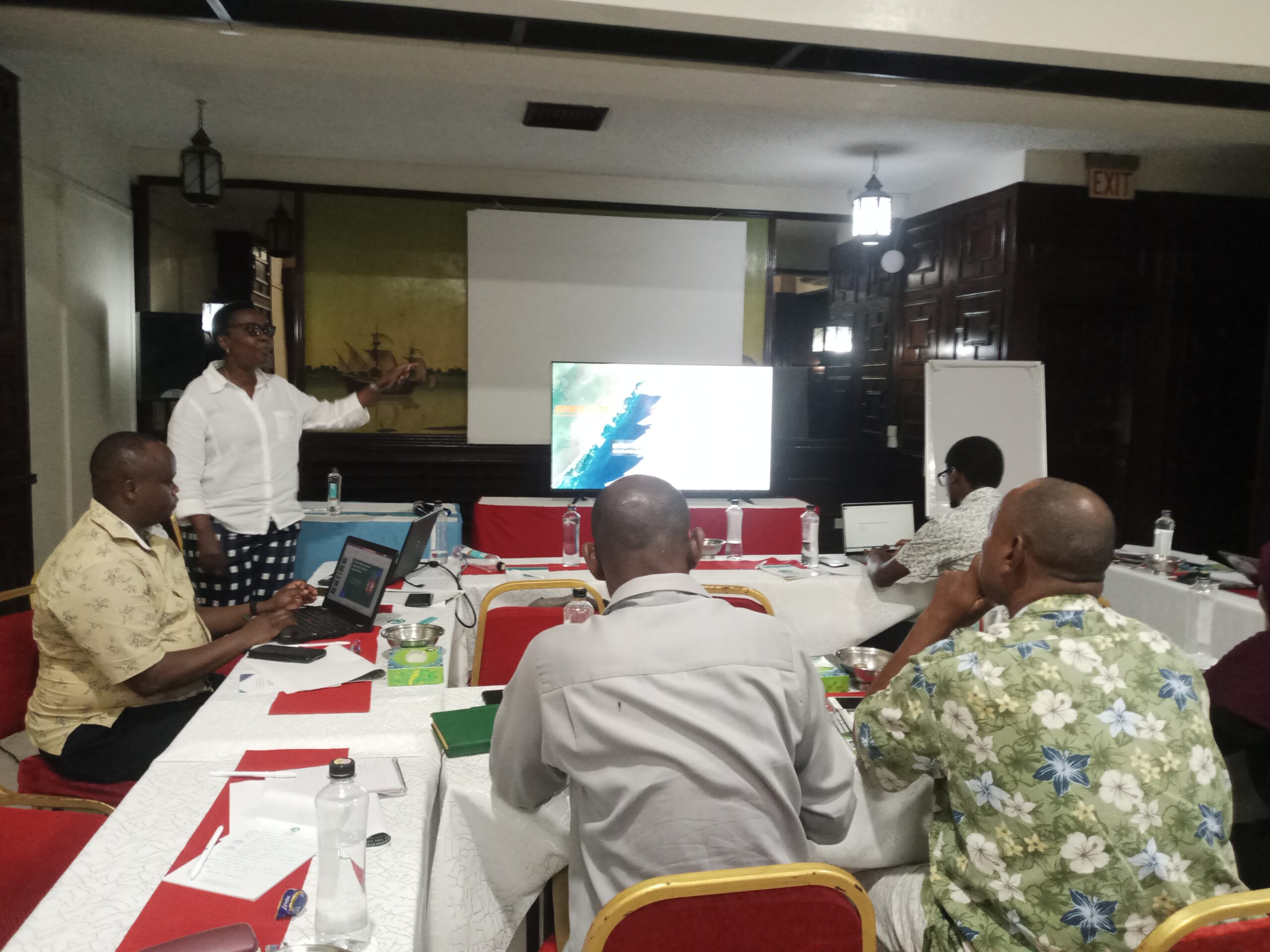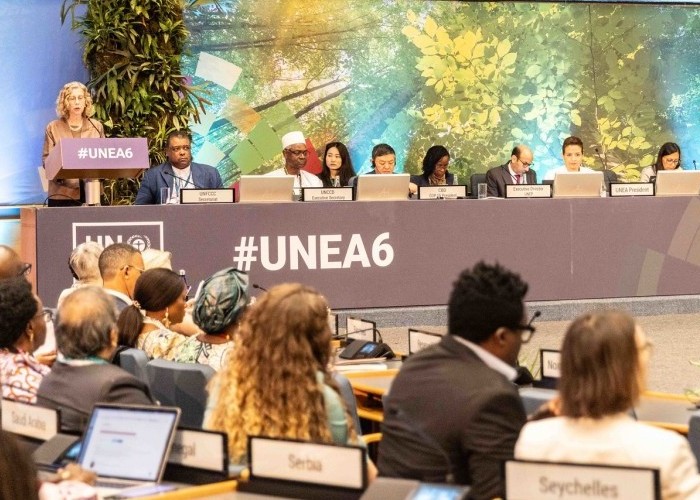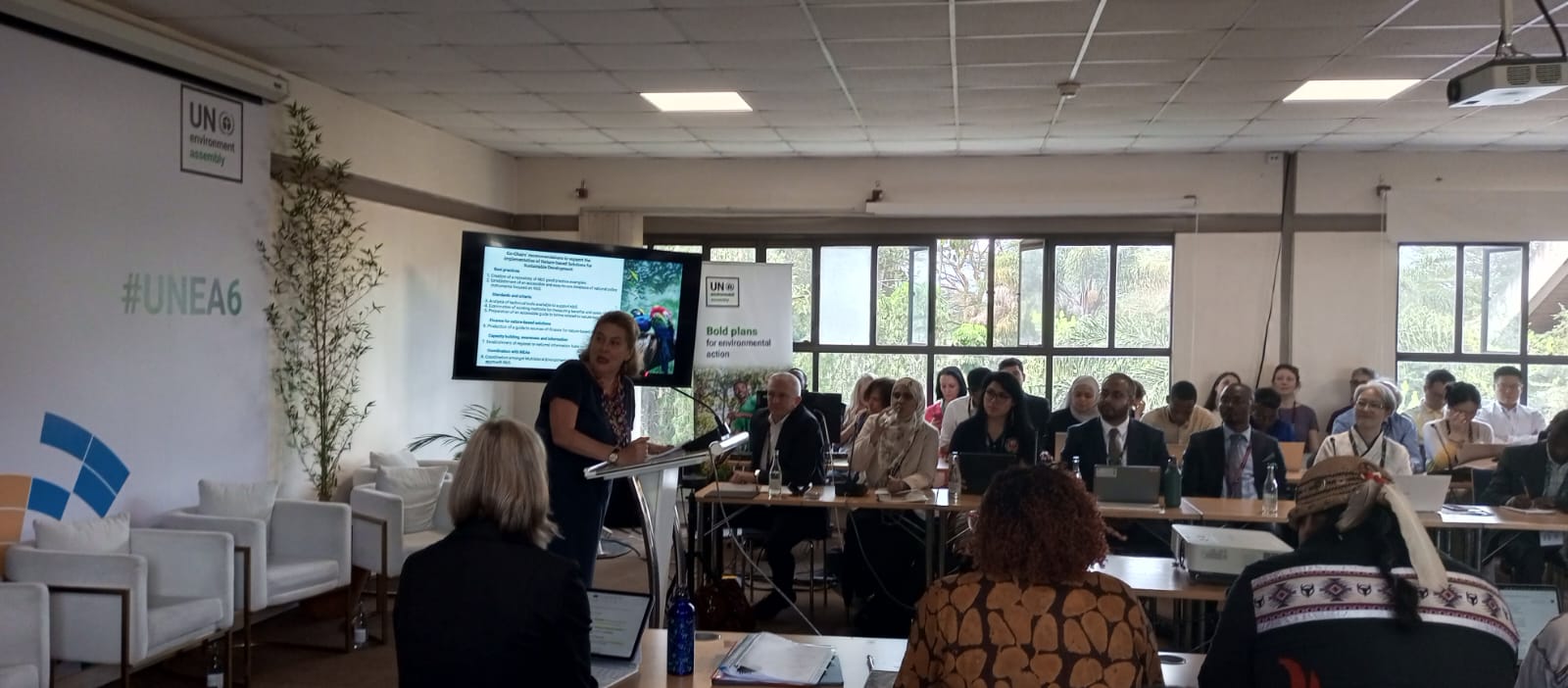Dr Emmanuel Mbaru (front left) and other members of Marine & Coastal Operations for Southern Africa and the Indian Ocean (MARCOSIO) consortium during the GMES&Africa Forum in Sham El Sheikh, Egypt| Photo courtesy WIOMSA
In the past elders would predict the weather and the warn fishermen of impending storms and their forecast was reliable. Fisheries was largely dependent on traditional knowledge for safety at sea and even for where to get a bumper catch of fish.
Such knowledge was particularly handy for artisanal fishers who control over 70 percent of the fishing activities in both marine and terrestrial waters.
In Kenya, for instance they form the majority of the fisher folk operating in the Indian Ocean from Vanga in the South Coast to Kiunga, Lamu, in the north coast of Kenya providing over 80 percent of household incomes.
So much has changed just like in the changing global weather patterns occasioned by climate change. The traditional forecasting is unpredictable as the weather and small scale fishers bear the brunt of the vagaries of weather due to dwindling stocks.
Discussions at the at the first forum of the Global Monitoring for Environment and Security in Africa (GMES & Africa) phase II at Sharm El Sheikh in Egypt have highlighted the importance of earth observation tools and services for supporting small scale fisheries and biodiversity conservation; and the usefulness of conference platforms for knowledge dissemination.
Dr Emmanuel Mbaru, a Senior Scientist at the Kenya Marine and Fisheries Research Institute (KMFRI) agrees that traditional knowledge was reliable and working but not anymore.
According to Dr Mbaru, artisanal fishers unlike commercial fisher folk use a multiplicity of gear including basket traps, gill nets, spear guns which have been banned and still being used, harpoon that is used to target octopus where women are also involved, then there is the hook and line.
“They basically target the same resource in terms of the species targeted. They definitely have no capacity to satisfy the local demand in Kenya. Most of them operate within the 12 nautical miles. They rarely target the offshore pelagic stocks like tuna and tuna-like species. They cannot therefore achieve to exploit fully the resource that is at sea,” he said.
According to the Food and Agriculture Organization (FAO) Voluntary Guidelines to Secure Small Scale Fisheries (VGSSF), small- scale fisheries encompass all activities along the value chain-pre-harvest, harvest and post-harvest.
The VGSSF were approved as an international instrument in June, 2014.These guidelines were created as a result of a very long history of the struggles of small-scale fish workers around the world appealing for greater recognition of their rights and their roles in the fisheries sector of their countries.
But all is not lost. Science, through extensive research has come up with interventions to help the fishers and also fill the deficit of fish as a result of limited capacity of artisanal fishermen.
Dr Mbaru says there are a number of initiatives and one of them, is aquaculture.
“Aquaculture is there to reduce the deficit that is currently existing in terms of the demand of fish by the local market. There are a number of species that have been tried such as tilapia, catfish but we also have milkfish. There is marine tilapia which has been tested.”
“At the Kenyan coast there are farmers that have been involved in crab fattening ventures and prawns farming,” he said.
There are a number of gadgets including those that can help them locate fish but these are not predictive applications. They have what is called the fish finders, a gadget that one can use to see whether there is fish underneath and this is mainly personal investment.
“However, there are a number of innovations in technology to help fishers increase their catch. One of them is the introduction of Fish Aggregating Devises (FADs). These are man-made structures that are set to float at sea, aggregating schools of fish rendering their capture easier. A fisherman will go straight to where this school of fish is and fish. It reduces their time of fishing, cost in terms of labour and fuel and it increases the probability of catching fish.
“These experiments were done in Kilifi in Kikambala and Mtwapa areas and Msambweni in Kwale County and it has been up and running. However, this is a very expensive undertaking and fishers have not been very cooperative. Most of the FADs that were deployed were vandalized by the same fishermen because they did not understand what these things were and the whole project has now collapsed,” says Dr Mbaru.
Long liners
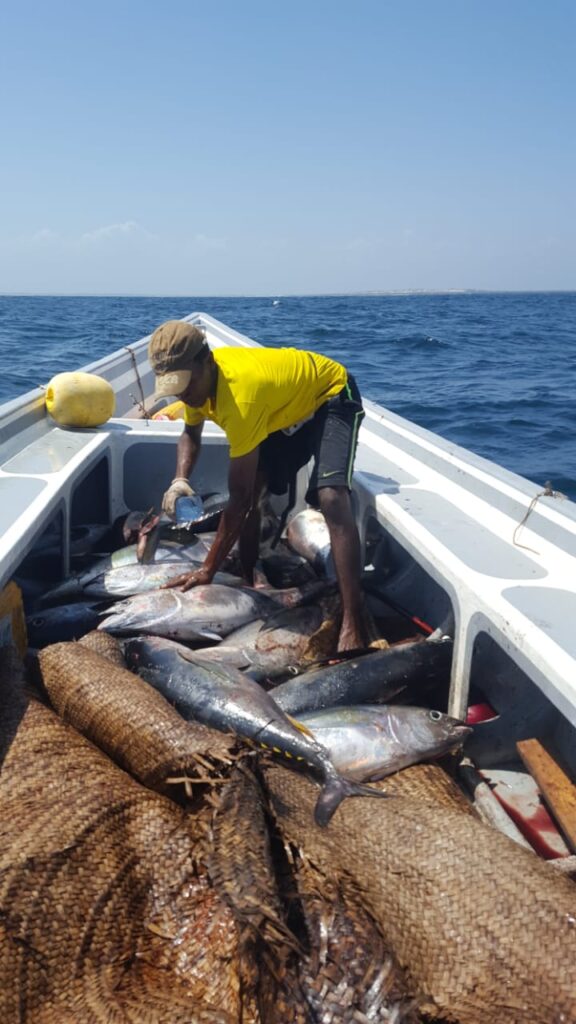
Another scientific intervention that has seen marked improvement in fish catch is the drop-line fishing –vertical long lines with hooks.
“In the entire Kenyan Exclusive Economic Zone (EEZ) or just the Kenyan territorial waters there is only one place where trawlers can operate and this is within the Malindi Ungwana Bay. Ungwana Bay has a smooth seabed without corals. The rest of the coastline is very rocky but there is fish there and the only way to fish there is through the use of drop line.
“The bumper fish that is common in Lamu and Malindi is harvested using the drop liners. This was an experiment that was tried in Ngomeni, Malindi and it has been very successful. If you go to the Kenyan north banks which are very productive fishermen are landing tons of large fish species because they adopted the technology and it has worked quite well in that area,” said the marine scientist.
Post-harvest losses
Saidi Mote, Ngomeni Beach Management Unit (BMU) Chairman says being a small scale fisherman is not easy especially when operating with limited resources.
One of the challenges that they have to contend with is that a lot of fish goes to waste due to inadequate storage facilities and capacity for value addition.
Without cooler boxes to preserve the bumper catch, the fishermen have to rush back to the shore in the hope of getting a good deal for the fish. On a day when over 10 boats set out for fishing, the landing would be anything between 600 kilogrammes to one ton of fish per vessel.
During the high season fishermen land tens of tons of fish. According to fishermen in Lamu, for instance, they are landing 50 tons of tuna daily but like in most other areas there is nowhere to sell except the local markets which are already saturated.
Dr Mbaru says Post-harvest loss is one area that demands a lot of investment but adds that the government has tried to set up a number of cold rooms in a number of landing sites and that’s really the solution by providing ice to the fishers to be able to preserve the fish and land the stock while they are still fresh.
In addressing safety and condition of the sea, most of the fishermen are turning to traditional knowledge although it is becoming unreliable due to climate change and they need help.
“It is science now coming to fill the knowledge gap although it’s not moving fast enough to communicate the information to the people. With climate change even the experts are challenged.
“This is why we are here at the GMES and Africa. When you find governments spending resources of this magnitude for earth observation, it means there is goodwill and commitment. Earth Observation is where the solution lies because we need to have data on the trends.
“GMES and Africa is trying to help countries have access to Earth Observation data therefore once that is realized we can use that data to model the future. We do those predictive models. We have the expertise and we can interpret this knowledge including the traditional knowledge as well,” said Dr Mbaru.
Background
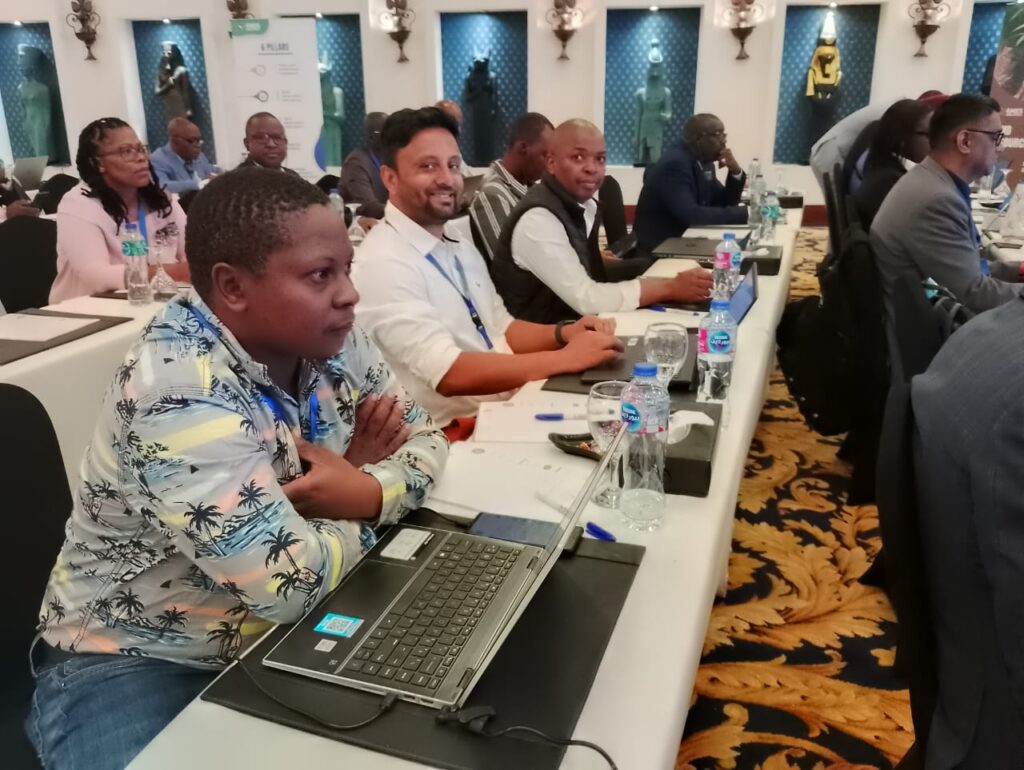
The Global Monitoring for Environment and Security (GMES) & Africa is comprised of eight consortia leading a network of over 120 national and regional institutions from Africa. GMES & Africa covers the entire African continent. This facilitates Earth Observation services enabling equal distribution of resources and strengthening capacity and collaboration across the entire continent.
The programme is currently implemented by eight consortia of institutions representing Eastern, Western, Northern, Southern and Central African regions.
The Africa Marine and Coastal Operations for Southern Africa and Indian Ocean (MarCOSIO) consortium, anchored by the Council for Scientific and Industrial Research (CSIR) comprises South Africa, Kenya, Tanzania, Madagascar, Angola, Mozambique, Mauritius, and Namibia. MarCOSIO is headed by Mr Sives Govender of CSIR.
KMFRI senior research scientist Dr Emmanuel Mbaru is a thematic expert and project leader for MarCOSIO- Kenyan Chapter, and is focused on developing tools that will enable fishers access satellite data obtained through electronic Catch Assessment System and Potential Fishing Zones applications – that provide fishers with data that will enable them to optimize fishing.
KMFRI has set up a ground receiving satellite data station with the capacity of generating fishing advisories in form of potential fishing zones (PFZ) for our local fishers.
CSIR has led her partner institutions in developing and implementing futuristic earth observation innovations for boosting water quality, aquaculture, and safety at sea and fisheries.


